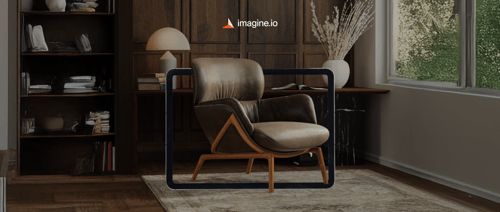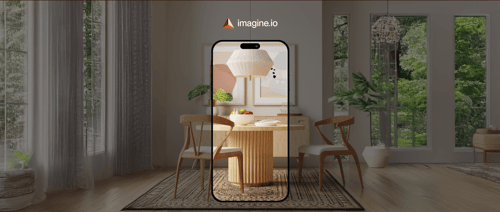Imagine browsing an online store for a new dining table. Instead of squinting at flat images, you're greeted with a vivid 3D model that rotates, zooms, and lets you swap finishes in real time. With a tap, your phone's camera places the table in your dining room, perfectly scaled to fit. This isn't a futuristic fantasy it's the cutting-edge reality of eCommerce, where platforms like imagine.io are revolutionizing product pages. As consumer demand for immersive shopping experiences surges, retailers across the United States and Canada are redesigning their digital storefronts to deliver interactive 3D and augmented reality (AR) visuals that rival the in-store experience, driving engagement and boosting conversions.
The Rise of Interactive Product Pages
The eCommerce landscape has transformed dramatically, with shoppers no longer satisfied by static images or grainy videos. Customers want to explore products as they would in a showroom rotating a lamp to see its finish, zooming in on a rug's texture, or visualizing an appliance in their home. This shift is fueling a revolution in product page design, where tools like imagine.io empower brands to create photorealistic 3D renderings and AR experiences. These technologies are becoming essential for retailers in key markets like New York, Los Angeles, Chicago, and Austin, where tech-savvy consumers expect seamless, engaging online experiences.
The numbers back this trend. A recent industry report forecasts the 3D retail merchandising software market to soar from USD 4.64 billion in 2025 to USD 15.75 billion by 2034, growing at a robust 14.53% CAGR. This growth is driven by retailer's focus on immersive shopping experiences that leverage 3D visualizations to enhance customer interaction and satisfaction, particularly in competitive eCommerce hubs.
Key Trends Shaping 3D and AR Visualization
Photorealistic CGI Redefines Quality
High-quality visuals are no longer exclusive to costly photoshoots. Platforms like imagine.io produce computer-generated imagery (CGI) so realistic that even seasoned eCommerce professionals can't distinguish it from traditional photography. This is critical for industries like furniture and home goods, where details matter. For brands like Ruggable or Serta Simmons, photorealistic 3D renderings showcase textures and finishes with stunning clarity, giving customers the confidence to buy without seeing the product in person.
AR: Bringing Products to Life
Augmented reality is transforming how customers shop by offering a “try-before-you-buy” experience. Retailers are embedding AR viewers into product pages, allowing shoppers to project products into their own spaces using a smartphone. Picture visualizing a KitchenAid mixer on your countertop or a Kohler faucet in your bathroom. This technology is particularly impactful in urban centers like Dallas and Las Vegas, where consumers value convenience and precision in their purchasing decisions.
All-in-One Visual Solutions
What sets imagine.io apart is its ability to deliver a full suite of visual formats static images, videos, 360° views, and interactive configurators from a single platform. Unlike competitors focused on one niche, this all-in-one approach streamlines content creation for brands like Kichler, which can display lighting fixtures in multiple angles, or PepsiCo, which might highlight packaging designs dynamically. This versatility ensures retailers can meet diverse customer needs across platforms like Instagram and LinkedIn.
Brands Leading the Charge
Furniture and Home Décor Innovators
For furniture retailers like Ruggable and King Koil, 3D visuals are a game-changer. Shoppers can explore a rug's weave or a mattress's design in intricate detail, rotating and zooming to inspect every angle. This is especially valuable in design hubs like High Point, where customers prioritize aesthetics. By mimicking the in-store experience, these brands create product pages that feel like virtual showrooms, driving engagement and reducing hesitation.
Appliances Go Interactive
Appliance manufacturers like Maytag, KitchenAid, and Amana are embracing 3D visuals to highlight product features. Interactive elements like exploded views or feature overlays let customers explore a dishwasher's interior or a stove's controls with ease. For retailers in tech-forward markets like Austin, these tools differentiate brands in a crowded field, making complex products accessible and appealing.
Lighting and Fixtures in Focus
Lighting and fixture brands like Kichler and Kohler face the challenge of conveying scale and finish online. Interactive 3D models solve this by letting customers visualize a chandelier's glow or a faucet's proportions in real-world settings. Shoppers can experiment with finishes or sizes, ensuring the product fits their space whether they're browsing from Chicago or Canada.
Addressing Adoption Challenges
Subscription Models vs. One-Off Projects
Despite the benefits, some retailers hesitate to adopt 3D and AR platforms due to ongoing subscription costs. Unlike one-off photoshoots, imagine.io's subscription model offers unlimited image production, ideal for brands with extensive catalogs like Hunter Fan or KegWorks. The cost savings and scalability of cloud-based platforms often outweigh traditional methods, especially for high-volume retailers.
Simplifying Custom Pricing
Pricing complexity is another concern. Imagine.io's custom pricing, tailored to each client's needs, can seem intricate compared to competitor's flat rates. However, the return on investment is clear: faster asset creation, lower return rates, and higher conversions. Retailers can justify the cost by focusing on long-term gains, particularly when engaging customers on social platforms like Facebook and YouTube.
Seamless eCommerce Integration
Integrating 3D assets into existing eCommerce platforms without compromising site speed is a technical hurdle. Best practices include optimizing file sizes and leveraging cloud rendering to ensure smooth performance. Brands like Serta Simmons have successfully embedded interactive visuals, proving that with the right setup, retailers can enhance user experience without sacrificing functionality.
Unlocking Business Opportunities
Accelerating Time-to-Market
Speed is critical in retail, and imagine.io's cloud-based platform delivers. Retailers can upload a product model and generate high-quality visuals in minutes no studio required. For brands like Diageo, launching new products swiftly is a competitive edge, especially in fast-moving markets like Los Angeles.
Scaling for Large Catalogs
Managing visuals for thousands of products is daunting, but imagine.io's unlimited image production simplifies the process. Whether it's Kohler's extensive fixture line or KegWork's diverse barware, retailers can scale visuals effortlessly, ensuring consistency across large catalogs in regions like Dallas or New York.
Boosting Customer Confidence
Immersive visuals do more than dazzle they drive results. By allowing customers to explore products in detail, 3D and AR reduce uncertainty, leading to fewer returns and higher satisfaction. The Market Research Future report emphasizes that 3D visualizations enhance customer engagement, a critical factor for brands leveraging social platforms like Instagram and YouTube to connect with shoppers.
The Future of Product Page Design
Product pages are no longer static they're dynamic, immersive tools that empower customers. Platforms like imagine.io are making 3D and AR accessible, enabling retailers to create engaging experiences that rival physical stores. Looking ahead, AI will further streamline asset creation, personalizing visuals for individual shoppers. Retailers should start by testing interactive formats on high-impact products and tracking engagement metrics on platforms like LinkedIn and Facebook. The message is clear: in a competitive eCommerce landscape, 3D and AR-powered product pages are not just innovative they're essential.
Frequently Asked Questions
How are 3D visuals and AR technology changing eCommerce product pages?
Retailers are replacing static product images with interactive 3D models and augmented reality features that allow customers to rotate, zoom, and visualize products in their own spaces. Platforms like imagine.io enable shoppers to explore product details as they would in a physical showroom, with AR viewers letting customers project furniture, appliances, and fixtures into their homes using smartphones. This transformation is driving higher customer engagement and reducing purchase hesitation by providing immersive shopping experiences.
What are the main benefits of using 3D product visualization for online retailers?
3D product visualization offers several key advantages including faster time-to-market with cloud-based asset creation, reduced return rates through better customer understanding of products, and the ability to scale visuals across large product catalogs without traditional photoshoot costs. Retailers can generate photorealistic CGI imagery in minutes, create multiple visual formats (360° views, videos, interactive configurators) from a single platform, and boost customer confidence by allowing detailed product exploration before purchase.
Which industries and brands are successfully implementing 3D and AR product experiences?
Furniture and home décor brands like Ruggable and King Koil are using 3D visuals to showcase textures and designs in detail, while appliance manufacturers including Maytag, KitchenAid, and Amana leverage interactive elements like exploded views to highlight product features. Lighting and fixture companies such as Kichler and Kohler use 3D models to help customers visualize scale and finishes in real-world settings. The 3D retail merchandising software market is projected to grow from $4.64 billion in 2025 to $15.75 billion by 2034, reflecting widespread adoption across industries.
Disclaimer: The above helpful resources content contains personal opinions and experiences. The information provided is for general knowledge and does not constitute professional advice.
You may also be interested in: 10 Furniture Brands With Stunning Product Visuals
Struggling with expensive, outdated product visuals that slow down your creative process and stunt eCommerce growth? imagine.io's AI-powered platform empowers furniture, home décor, and textile brands to effortlessly produce striking 3D images, immersive videos, AR experiences, and interactive configurators. Cut production costs up to 70%, boost conversions 5X, speed up prototyping, and supercharge your online sales. Ready to elevate your product visuals and captivate customers? Book a demo with imagine.io today!
Powered by flareAI.co




.png?width=500&name=How%20to%20Add%20a%203D%20Product%20Configurator%20to%20Your%20WordPress%20Website%20(Complete%20B2B%20Guide).png)
















%20(1).png?width=500&name=Why%20Exploded%20Mattress%20Views%20Matter%20(And%20How%20to%20Generate%20Them)%20(1).png)
.png?width=500&name=Best%20Shopify%20Product%20Configurator_%20How%20to%20Choose%20the%20Right%20One%20(2).png)
.png?width=500&name=Why%20Exploded%20Mattress%20Views%20Matter%20(And%20How%20to%20Generate%20Them).png)



.png?width=500&name=Best%20Shopify%20Product%20Configurator_%20How%20to%20Choose%20the%20Right%20One%20(1).png)







.png?width=500&name=How%203D%20Rendering%20Can%20Make%20or%20Break%20Your%20Industrial%20Design%20Pitch%20(1).png)








%20with%20Digital%20Twins%20and%203D%20Visualization.png?width=500&name=Optimizing%20Your%20Digital%20Asset%20Management%20(DAM)%20with%20Digital%20Twins%20and%203D%20Visualization.png)




.png?width=500&name=Styling%20Home%20Decor%20for%202025_%20From%20Global%20Influences%20to%20Playful%20Personalization%20(1).png)
